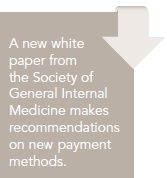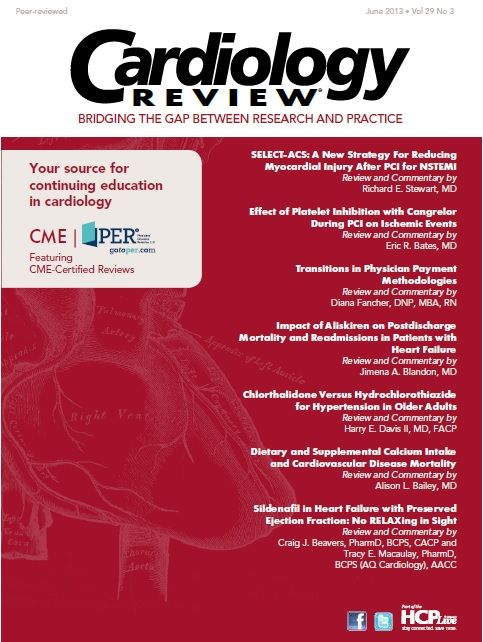Publication
Article
Cardiology Review® Online
Transitions in Physician Payment Methodologies

Diana Fancher, DNP, MBA, RN
Review
Schroeder SA, Frist W. Phasing out fee-for-service payment. N Engl J Med. 2013: 1-4.
In the face of looming requirements in the 2010 Patient Protection and Affordable Care Act (ACA), a white paper, “Phasing Out Fee-For-Service Payment,” was published in the New England Journal of Medicine. In the article, Steven A. Schroeder, MD, and William Frist, MD, summarized the recommendations that grew out of the March 2012 meeting of the National Commission on Physician Payment Reform, which was convened by the Society of General Internal Medicine. This Commission was established to recommend payment methods that will maximize good clinical outcomes, improve patient and physician satisfaction and autonomy, and provide cost-effective care.

The commission was assembled with the awareness that the current level of spending for health care in the United States is not sustainable, there is poor return on investment, and that the current model of physician payment drives high medical expenditures. Following a review of health care cost drivers in the United States, several contributing factors were identified, including reliance on technology and expensive care, higher cost for services performed at a hospital-owned facility that could be performed in an outpatient setting, and a high proportion of specialists compared with general physicians. The most important cause of high health care expenditures was found to be fee-for-service reimbursement.
The commission developed a blueprint of 12 recommendations for aggressive approaches to changing the current methods of physician payment. The first recommendation states that, over time, payers should largely eliminate stand-alone fee-for-service payments to medical practices because of its inherent inefficiencies and problematic financial incentives: duplication of services, increases in the volume of health care usage, and discouragement of coordination of care. In addition, recommendations 3 and 11 are specific to fee-for-service implementation, and advocate maximization of cost savings and quality of care early in the initial payment reforms.
An emphasis is placed on quality, value, and outcome-based performance reimbursement, with a focus on making changes to payment methods significant enough to motivate providers to move toward a substantial change in behavior.
Recommendations 2 and 6 address outcomes and quality. Disease prevention and the management of chronic diseases are preferred over the treatment of illness. This allows health care providers to place value on examination and diagnosis that is equal to performing procedures. This changed emphasis will necessitate altering the current payment model to one that may include bundled payments, capitation, and increased financial risk sharing. A transition period will be needed, with the potential result of a blended system of payment, including fee-for-service, capitation, and salary.
Recommendations 4, 5, and 9 are related to increasing payments for evaluation and management codes, the inequity of different reimbursement amounts for the same procedures completed in different care settings, the promotion and support of evidence-based practice, and the importance of risk adjustments for any type of fixed payment. The recommendations suggest the elimination of the current practice of increased reimbursement for services that can be performed in lower-cost settings (the current trend being higher payment for services provided in the hospital setting). Transparency and equal reimbursement for physician services regardless of the specialty or setting is necessary to stem the rising cost of health care, as more hospitals are purchasing physician groups. The remaining recommendations have to do with increased payments for innovations, fixed payments, and transparency.
CommentaryAn Attempt to Create a Guiding Coalition
Since becoming law in March 2010, the road for the ACA has had its share of bumps and controversy. The ACA withstood a second-round deliberation ending with the US Supreme Court upholding the law in June 2012.1 The wide range of public opinion about the ACA has created an environment ripe for a great deal of speculation. Because the ACA affects such a wide variety of vested health care organizations and individuals, the unknown aspects related to the future of US health care is at the forefront of importance today and in the future.
During the first 3 years of ACA implementation, the focus was on new consumer protections, improving quality and lowering health care costs, increasing access to affordable care, and holding insurance companies accountable.2 Effective January 1, 2013, the law requires the start of a national pilot program to motivate hospitals, physicians, and providers to collaborate in order to improve the coordination and quality of care for patients. The different health care providers treating a patient for the same or related condition are paid in “bundled” payments for the care rather than for each individual test or procedure.3 A portion of the resulting cost savings would then be paid to the providers involved in the care. This forced collaboration may be one of the more contentious stipulations in the ACA, in my opinion. Change is difficult under any circumstances; the implementation of change at the corporate and individual level, with the integration of these entities, will require a level of communication and teamwork that will be extremely difficult to achieve.
In my experience, physicians, hospitals, and insurance providers have not historically collaborated in a mutually beneficial manner. The environment in which they operate is, at times, driven by a desire to protect autonomy and self-interest. The entire landscape of health care is changing in today’s world. The bundling of payments will be a change in perception and behavior more than a mechanical or a rule change. Failing to create a sufficiently powerful guiding coalition is one of the big mistakes in creating change; inversely, creating a vision and a guiding coalition is a critical step in the process of change.1
The National Commission on Physician Payment Reform appears to be making an attempt to create a vision and develop a guiding coalition, although some believe these recommendations were developed to protect this Commission’s autonomy and selfinterest. A recent opinion piece by Wes Fisher, MD, FACC, expresses concerns related to the Commission members’ backgrounds as academic internists and executives with deep ties to large managed care companies, hospital corporations, and private investment firms connected to the health care industry, as well as the formation of the National Commission seemingly “out of thin air,” and the perception that this group was not really formed solely in the interest of physician payment reform.4 Fisher’s request for a simple and fair payment system for physicians is not asking too much, in my opinion. As I have learned more about the imminent ICD-10 procedure codes, questions have crossed my mind as to whether “this will be the end of us.”
Conclusion
Bundling of hospital, physician, and provider payments will be a complete change in how health care is provided. The intent to improve quality, coordinate care, and decrease costs is noble, but will serve to create new chasms of difficulty during this realignment and change in perceptions, behavior, and expectations. The National Commission on Physician and Payment Reform, created by the Society of General Medicine, may serve as an attempt to create a vision and to form a coalition, although it is apparent that not all physicians are in agreement with this vision. This is the challenge that must be addressed now and in the future.
References
1.The 2010 Patient Protection and Affordable Care Act [HR3590]. www .gpo.gov/fdsys/pkg/PLAW-111PUBLI1148/PDF/paw-111publ1148.pdf.
2. Healthcare.gov. Taking healthcare into your own hands. www.healthcare. gov/law/timeline/full.html.
3. Kotter JP. Leading change. Boston, MA: Harvard Business School Press; 1996.
4. Fisher W. The physician pay reform I’d like to see. www.medpagetoday .com/DrWes/38294.
About the Author
Diana Fancher, DNP, MBA, RN , is Chief Nursing Officer at the University Medical Center of El Paso in El Paso, TX, where she administers, directs, and coordinates patient care services and operations in this 394-bed acute care facility/Level 1 trauma center/academic teaching hospital. Dr. Fancher has over 19 years of experience in health care and is a member of the hospital’s senior executive team in planning, policy formation, strategic decisions and implementation, and is directly responsible for an $85 million operational budget and $2 million capital budget.






